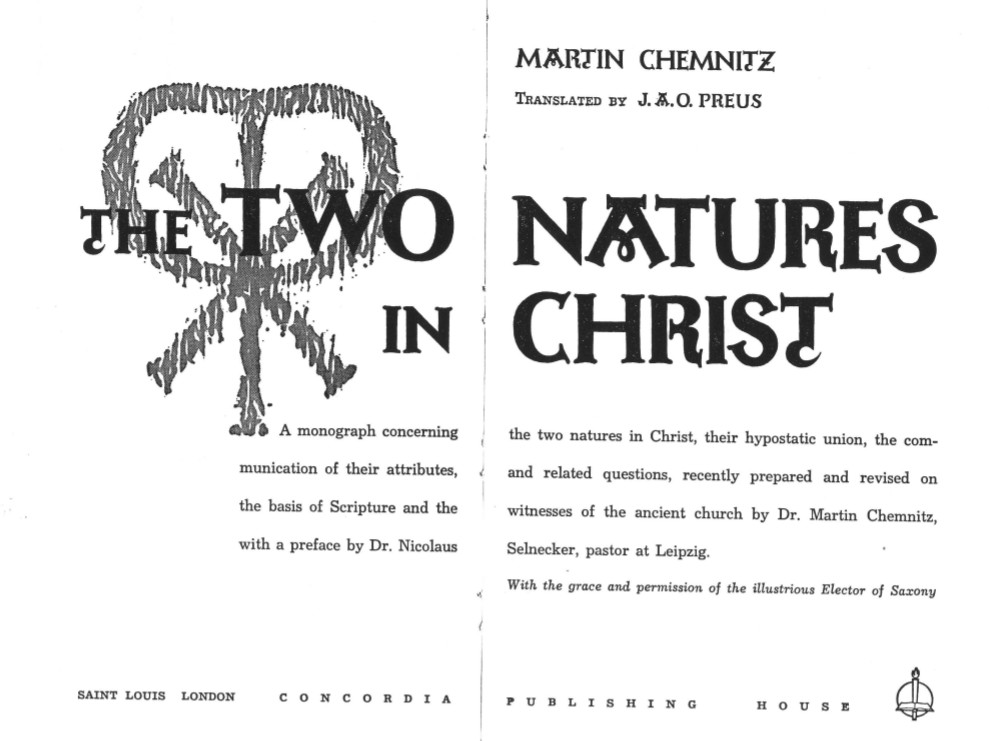 There’s nothing like the incarnation of the Son of God. The union of divine and human in Christ is unique; it is a strongly unique kind of union. In fact, it’s so strongly unique that there is a theological tradition of highlighting its uniqueness by listing every other kind of union conceivable, just to be able to say the incarnation isn’t any of them. Cyril of Alexandria used this pedagogical strategy, and following him John of Damascus did also. But standing on their shoulders, the Lutheran systematician Martin Chemnitz (the second most important person named Martin in the whole Lutheran tradition, I kid you not) produced a very long list of unions that the incarnation isn’t.
There’s nothing like the incarnation of the Son of God. The union of divine and human in Christ is unique; it is a strongly unique kind of union. In fact, it’s so strongly unique that there is a theological tradition of highlighting its uniqueness by listing every other kind of union conceivable, just to be able to say the incarnation isn’t any of them. Cyril of Alexandria used this pedagogical strategy, and following him John of Damascus did also. But standing on their shoulders, the Lutheran systematician Martin Chemnitz (the second most important person named Martin in the whole Lutheran tradition, I kid you not) produced a very long list of unions that the incarnation isn’t.
This is from chapter 7 of his monumental Two Natures in Christ, which serious christology students ought to read, mark, learn, and inwardly digest.¹
“The hypostatic union in Christ,” Chemnitz tells us, “differs from all other modes of union, presence, and indwelling.” (110) To prove that, he lists no fewer than fourteen other kinds of union (starting at p. 105):
1. Through destruction (of both)
2. Through conversion (of one into another)
3. Through fusion (blending, third compound)
4. Through heaping up
5. Through proximity
6. Through condition
7. Through agreement
8. Through sharing or grace
9. Through appearance
10. Through prosopic union (as in Spirit indwelling believer)
11. Through substantial union (as in the Trinity)
12. Through carnal union
13. Through spiritual union
14. Through essential union (as soul and body)
In case fourteen isn’t a long enough list, Chemnitz goes on to list seven other modes of divine presence that you might think are like the incarnation. Here are ways that God can be present, which are not the unique way God is present in Christ:
1. By universal presence of the entire Trinity to the entire universe
2. By the indwelling of the whole Trinity in saints
3. By copresence with angels
4. By revelation of divine presence as in a theophany
5. By ministry in word and sacrament
6. By instrumental presence, through prophets, apostles, etc.
7. As the Father is in the Son and the Son in the Father
This is not what people call negative theology, but it’s certainly an instructive use of negations to sharpen the point of theology. And it accomplishes something very helpful in preventing the mind from being falsely satisfied.
We might say it this way: The Word became flesh (John 1:14), but the kind of becoming that happened to the Word is unlike any other kind of becoming. The Word didn’t morph into flesh, or stop being Word and instead be flesh, or… well, see the 21 negations above.
You may be ready to press on and ask what kind of becoming this strongly unique incarnational becoming is. Chemnitz has answers, primarily in the form of exegesis of key Scriptures. He interprets “became” (egeneto) by comparing it with New Testament words like share, partake, and assume (Heb 2:16, epilambanesthai), along with some other enlightening terms. Chapter 9, entitled “Light Shed by Main Words Used by Scripture and Ancient Church,” is longer and more detailed than the negative chapter I’ve highlighted here. Paying careful attention to the New Testament and to his favorite Greek fathers (Cyril of Alexandria and John of Damascus), Chemnitz carefully limns the unique reality of the incarnation.
______________________________
¹Chemnitz’ The Two Natures is of course very Lutheran, like gold standard, no-fooling, ganz echt totes Lutheran. So there’s going to be some genus majestaticum getting communicated at some point, and then ubiquitarianism can’t be far behind. But if you know enough to care about that, you already don’t need this footnote to warn you about it. Read Chemnitz critically, but read him.